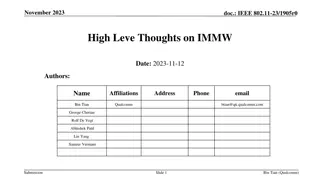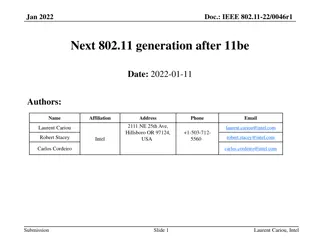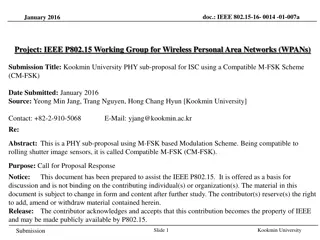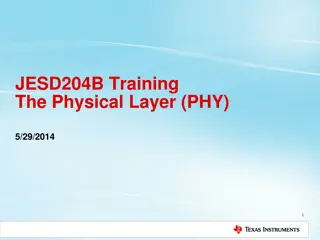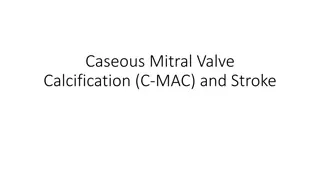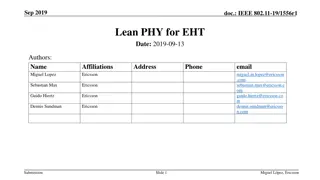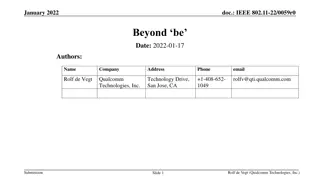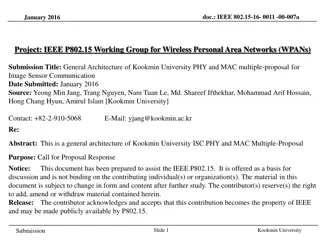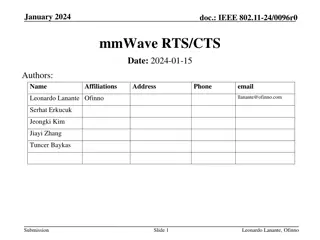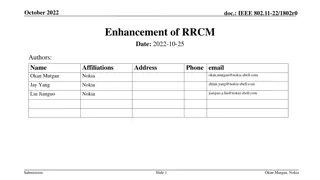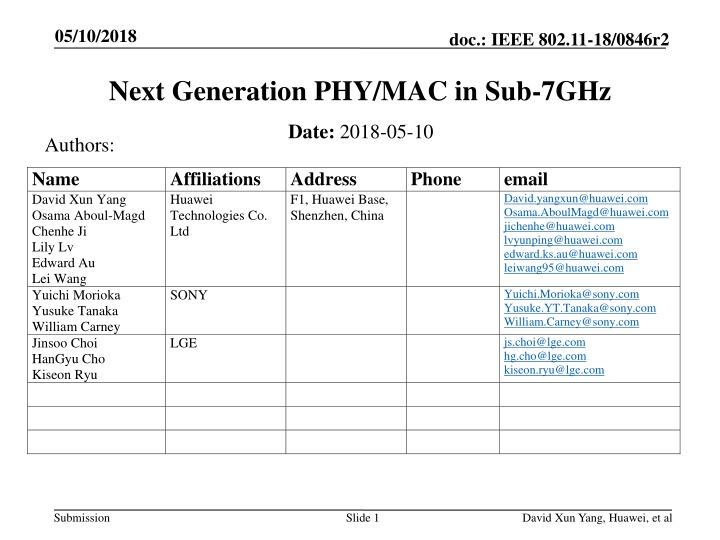
IEEE 802.11-18/0846r2 Next Generation PHY/MAC in Sub-7GHz
Explore the advancements in the IEEE 802.11-18/0846r2 standard proposal for Next Generation PHY/MAC technologies within the Sub-7GHz spectrum, presented by a group of authors from Huawei, Sony, and LG Electronics. Delve into the proposed timeline, important use cases, requirements, and candidate technologies outlined in the submission slides.
Download Presentation

Please find below an Image/Link to download the presentation.
The content on the website is provided AS IS for your information and personal use only. It may not be sold, licensed, or shared on other websites without obtaining consent from the author. If you encounter any issues during the download, it is possible that the publisher has removed the file from their server.
You are allowed to download the files provided on this website for personal or commercial use, subject to the condition that they are used lawfully. All files are the property of their respective owners.
The content on the website is provided AS IS for your information and personal use only. It may not be sold, licensed, or shared on other websites without obtaining consent from the author.
E N D
Presentation Transcript
05/10/2018 doc.: IEEE 802.11-18/0846r2 Next Generation PHY/MAC in Sub-7GHz Date: 2018-05-10 Authors: Name David Xun Yang Osama Aboul-Magd Chenhe Ji Lily Lv Edward Au Lei Wang Yuichi Morioka Yusuke Tanaka William Carney Jinsoo Choi HanGyu Cho Kiseon Ryu Affiliations Huawei Technologies Co. Ltd Address F1, Huawei Base, Shenzhen, China Phone email David.yangxun@huawei.com Osama.AboulMagd@huawei.com jichenhe@huawei.com lvyunping@huawei.com edward.ks.au@huawei.com leiwang95@huawei.com Yuichi.Morioka@sony.com Yusuke.YT.Tanaka@sony.com William.Carney@sony.com SONY js.choi@lge.com hg.cho@lge.com kiseon.ryu@lge.com LGE Submission Slide 1 David Xun Yang, Huawei, et al
05/10/2018 doc.: IEEE 802.11-18/0846r2 Outline Timeline and Proposed Standard Procedure Important Use Cases Requirements and Candidate Technologies Submission Slide 2 David Xun Yang, Huawei, et al
05/10/2018 doc.: IEEE 802.11-18/0846r2 Thoughts on the Timeline 2004 2018 2003 2019 2023 2017 2009 2007 2012 2013 Feb 2012 Mar 2013 Sep 2017 Sep 2002 Mar 2007 HT SG: 12 months 802.11n Draft 2.0 11n SG: HT 802.11ac VHT SG: 18 months 11ac SG: VHT Draft 2.0 HEW SG: 12 months 802.11ax 11ax SG: HEW Draft 2.0 SG for next PHY/MAC: ? Next PHY/MAC (see next slides) NG SG SG Formation Sep 2002 Mar 2007 Mar 2013 July 2018? PAR Sep 2003 Sep 2008 Mar 2014 ? First LB April 2006 June 2011 Nov 2016 First LB>75% Mar 2007 Feb 2012 July 2018? Last LB Dec 2008 Feb 2013 ? Last SB July 2009 Nov 2013 ? 11n 11ac 11ax Next PHY/MAC If the LB for IEEE 802.11ax D3.0 is started after the May 2018 interim and the LB is passed, then the draft amendment is relatively stable and it is reasonable to plan for the next PHY/MAC release. Besides, there is no difference for the SG actual creation time between motion it in May vs July due to 802EC Submission Slide 3 David Xun Yang, Huawei, et al
05/10/2018 doc.: IEEE 802.11-18/0846r2 Thoughts on Standard Development (1) It took a long time to develop a new major PHY/MAC amendment. The PARs are written in a generic manner Mostly because there are many features considered PAR and CSD Technical Contribution Letter Ballot Sponsor Ballot Approx. time line for n/ac 1 year 2 years 2 years 0.5 year Task Group Study Group Submission Slide 4 David Xun Yang, Huawei, et al
05/10/2018 doc.: IEEE 802.11-18/0846r2 Thoughts on Standard Development (2) Can we improve the standards development process to shorten the time for bringing new technologies to the market? Take IEEE 802.1 as an example. Some of its projects, e.g., 802.1Qcc, 802.1Qcd, are completed in 2 years, and these projects were developed with very narrow scopes. Is it an appropriate time to take a deep dive on our WG process? Is there any benefit of starting a project with very narrow scopes? For example, define a PAR with a very focused set of features Submission Slide 5 David Xun Yang, Huawei, et al
05/10/2018 doc.: IEEE 802.11-18/0846r2 Proposed approaches (1) Option 1: Divide a major PHY/MAC amendment into multiple projects, each with a narrowly- defined feature set In WNG SG, discuss market-driven features, and prioritize the features into multiple projects It is possible to develop a PAR and CSD without forming a study group. For example, the PAR of TGmd was developed in the Working Group. See: http://www.ieee802.org/11/email/stds-802-11/msg02506.html Nothing needed for SG to prepare a PAR in 802 OM. See: https://mentor.ieee.org/802-ec/dcn/17/ec-17-0090-21-0PNP-ieee- 802-lmsc-operations-manual.pdf PAR, CSD for set 1 Contributions for set 1 Letter Ballot for set 1 Sponsor Ballot for set 1 Project 1 (approx. 1.5~2 years) PAR, CSD for set 2 Contributions for set 2 Letter Ballot for set 2 Sponsor Ballot for set 2 Project 2 (approx. 1.5~2 years) Certification program outside of IEEE for set 1 Certification program outside of IEEE for set 2 Submission Slide 6 David Xun Yang, Huawei, et al
05/10/2018 doc.: IEEE 802.11-18/0846r2 Proposed approaches (2) Option 2: Divide a major PHY/MAC amendment into multiple phases within a task group, each phase with a narrowly-defined feature set A few issues need to be considered, e.g., can we roll-in text for set 2 into the draft amendment if the letter ballot for set 1 is passed? Can we follow 11m approach for the roll-in? PAR, CSD for whole project Contributions for set 1 Letter Ballot for set 1 Phase 1 (approx. 1.5~2 years) Contributions for set 2 Letter Ballot for set 2 Phase 2 (approx. 1.5~2 years) Certification program outside of IEEE for features in Phase 1 Certification program outside of IEEE for features in Phase 2 Submission Slide 7 David Xun Yang, Huawei, et al
05/10/2018 doc.: IEEE 802.11-18/0846r2 Important Use Cases for Next Gen Video Transmission VR (Page 9 & 10) 8k (Page 11) Improved IoT Support See page 12 Industrial Wi-Fi See page 13 & 14 Submission Slide 8 David Xun Yang, Huawei, et al
05/10/2018 doc.: IEEE 802.11-18/0846r2 VR Use Cases VR Movie, VR Gaming, Virtual Social, VR Live Broadcasting AP plays a key role in VR system Bad Experience: Insufficient image clarity Image smearing Black border Dizziness Cloud VR Head display is very heavy because of lots of image processing Home VR Portable VR Submission Slide 9 David Xun Yang, Huawei, et al
05/10/2018 doc.: IEEE 802.11-18/0846r2 VR Requirement The requirement of VR is calculated in the following table Monocular Video Resolution Lightly Compressed Rate (Gbps) Horizont al FOV Vertical FOV Bits per Pixel Fram e Rate Yuv444/ yuv420 Raw Rate (Gbps) Compressed Rate (Gbps) RTT Latency PPD 2D, 40.83/ 20.42 2D, 4.83/ 2.04 2D, 0.48/ 0.20 Partial Immersion 30 210 100 6300*3000 12 60 3/1.5 10ms 3D, 81.66/ 40.84 3D, 9.66/4.04 3D, 0.97/0.40 2D, 2D, 23.6/ 11.8 2D, 2.36/1.18 236.20/118.10 Deep 45 360 100 16200*4500 12 90 3/1.5 5ms Immersion 3D, 3D, 47.2/23.6 3D, 4.72/2.36 472.40/236.20 2D, 2D, 80.62/ 40.31 2D, 8.06/4.03 806.22/403.11 Ultimate Immersion 60 360 120 21600*7200 12 144 3/1.5 5ms 3D, 3D, 3D, 16.12/8.03 1612.44/806.22 161.24/80.62 Typical requirement of VR for Wireless Transmission Total latency should <20ms, T(compression & decompression)=~10ms, T(display)=5ms, T(rendering)=1ms? RTT Latency 5~10ms To meet the above latency requirement, raw stream or lightly compressed stream is preferred PHY Link Throughput > 40Gbps Submission Slide 10 David Xun Yang, Huawei, et al
05/10/2018 doc.: IEEE 802.11-18/0846r2 4K/8K Video Uncompressed 8K Video is more and more important for home/Enterprise CCTV Signals Wireless HDMI RAW Stream Cloud Streaming (VDI/Live Broadcasting/ ) Traffic Subtype Description Rate, Mbps Packet Error Rate Jitter, ms Delay, ms 4k*2k pixels, 12bits/pixels, 60fps 6000 1e-8 Video Uncompressed 10 10 8k*4k pixels, 12bits/pixels, 60fps 23000 1e-8 4k*2k, Motion JPEG2000 600 1e-7 20 20 Video Lightly Compressed Videos 8k*4k, Motion JPEG2000 2400 1e-7 20 20 4k*2k pixels, 60fps 100 3e-7 20 20 Video Compressed 8k*4k pixels, 60fps 250 3e-7 20 20 Submission Slide 11 David Xun Yang, Huawei, et al
05/10/2018 doc.: IEEE 802.11-18/0846r2 IoT-Fi Wi-Fi IoT has been supported by 11b, 11n, and 11ax Power efficiency is not so good as the other technologies Other technologies cannot coexist with Wi-Fi very well Target of IoT-Fi: work with main stream Wi-Fi in both 2.4GHz and 5-7GHz very well with more efficient power consumption Voice/Video Voice Control Control Data Report Voice Sensors, Meters, Control/Voice Submission Slide 12 David Xun Yang, Huawei, et al
05/10/2018 doc.: IEEE 802.11-18/0846r2 Industrial Wi-Fi Industrial 4.0 requires lots of intelligent equipment and operation Wi-Fi should play a key role in the connection Warehouse: Location of Materials; Location and Control of Robots Textile Industry: Interconnection of Devices Assembly Line: Control of Robotic Arms Chemical/Materials: Wireless Monitoring and remote management Highway Management: Video Backhaul and Equipment Tracking Manufacturing: Wireless monitoring and Management of Equipment Submission Slide 13 David Xun Yang, Huawei, et al
05/10/2018 doc.: IEEE 802.11-18/0846r2 Requirement of Industrial Wi-Fi There are many systems in industrial scenario operating independently, e.g., monitoring system, mechanical control, system maintenance, etc. Wi-Fi can be a united access method for all the systems. Detailed Requirements of Industrial Wi-Fi Latency Scenarios Automation Monitoring Mechanical Control Motion Control Latency <50ms <100ms 10-50ms <10ms More reliable transmission Overcome interference, temperature change, etc. Security Submission Slide 14 David Xun Yang, Huawei, et al
05/10/2018 doc.: IEEE 802.11-18/0846r2 Summary of Requirements Enhanced PHY link throughput Compared to 11ac, 11ax only has minor enhancement on link throughput NG should has significant throughput enhancement over 11ax. For example, peak throughput: 40Gbps? Enhanced AP throughput Larger number of users per AP than 11ax Reliable Transmission Lower PER Latency Less than 5-10ms for VR application Less than 10-100ms for Industrial Wi-Fi Network Efficiency Further mitigate inter-BSS interference Power Efficiency Similar to other low power technologies at IoT only STA side Submission Slide 15 David Xun Yang, Huawei, et al
05/10/2018 doc.: IEEE 802.11-18/0846r2 Discussion of Candidate Technologies For example, the following technologies can be considered based on requirements Full Duplex (Co-channel STR) PHY Link Throughput AP Collaboration AP Throughput VR/Video Larger Bandwidth Reliable Transmission IoT-Fi More Spatial Streams Network Efficiency Industrial Wi-Fi IoT Mode narrower than 20MHz Power Efficiency Multi-Band Operation (Channel Aggregation, more scheduling, etc) Latency New Modulation/Coding HARQ Enhanced Spatial Reuse To match the proposed approaches on standard development, the above features can be grouped as follows for instance assuming that features - are adopted Project1/Phase1: Project2/Phase2: Project3/Phase3: Submission Slide 16 David Xun Yang, Huawei, et al
05/10/2018 doc.: IEEE 802.11-18/0846r2 Way Forward Consider the following between now and the end of July plenary: for the Working Group to take a deep dive on the standards development process and see if any improvement is needed. for the WNG SC to discuss on and prioritize features of next PHY/MAC amendment if the direction is to consider PARs with narrow focus. Submission Slide 17 David Xun Yang, Huawei, et al
05/10/2018 doc.: IEEE 802.11-18/0846r2 Thank You Submission Slide 18 David Xun Yang, Huawei, et al
05/10/2018 doc.: IEEE 802.11-18/0846r2 Reference [1]. http://sd.iqilu.com/share/article/4642056.html [2]. http://wearablesinsider.com/2017/02/e-skinny-xenomas-smart-shirt/ [3]. http://www.fxiang.com/item/id/VlGkaW37aQEA.html [4]. http://toc.cassianetworks.com/collections/products/light/ [5]. 11-13-0657-06-0hew-hew-sg-usage-models-and-requirements-liaison-with-wfa Submission Slide 19 David Xun Yang, Huawei, et al
05/10/2018 doc.: IEEE 802.11-18/0846r2 SP1 Which option on page 6 and 7 do you like to speed up the standard development of a major PHY/MAC project? Option 1 Option 2 Abs Neither/Other option Submission Slide 20 David Xun Yang, Huawei, et al
05/10/2018 doc.: IEEE 802.11-18/0846r2 SP2 Do you agree the use cases listed on page 8 should be considered in the next gen development? Video Transmission (Y/N/Abs) IoT-Fi (Y/N/Abs) Industrial Wi-Fi (Y/N/Abs) Submission Slide 21 David Xun Yang, Huawei, et al


